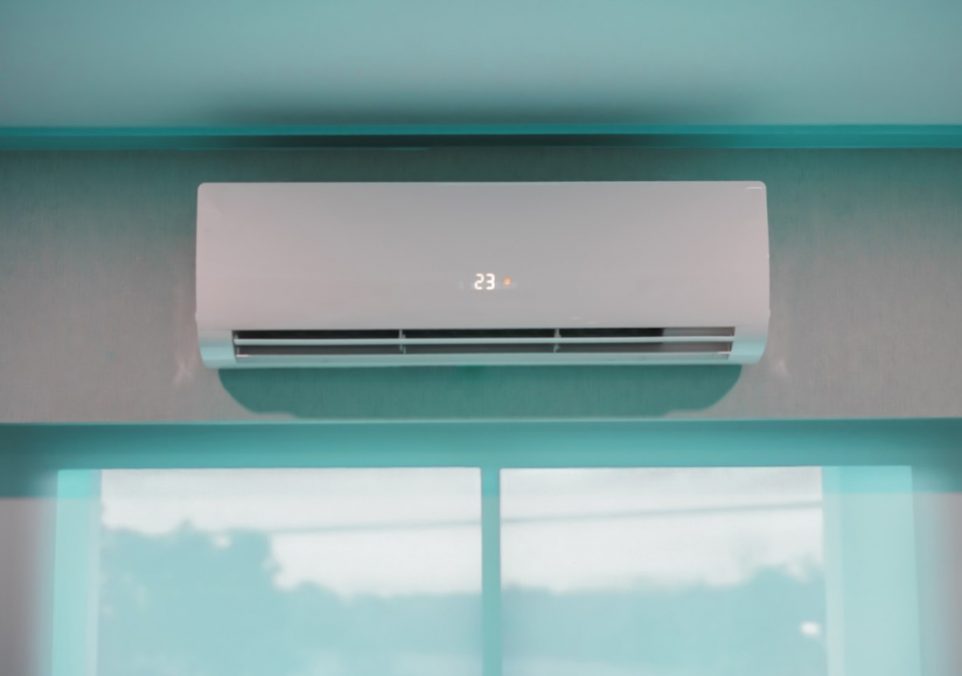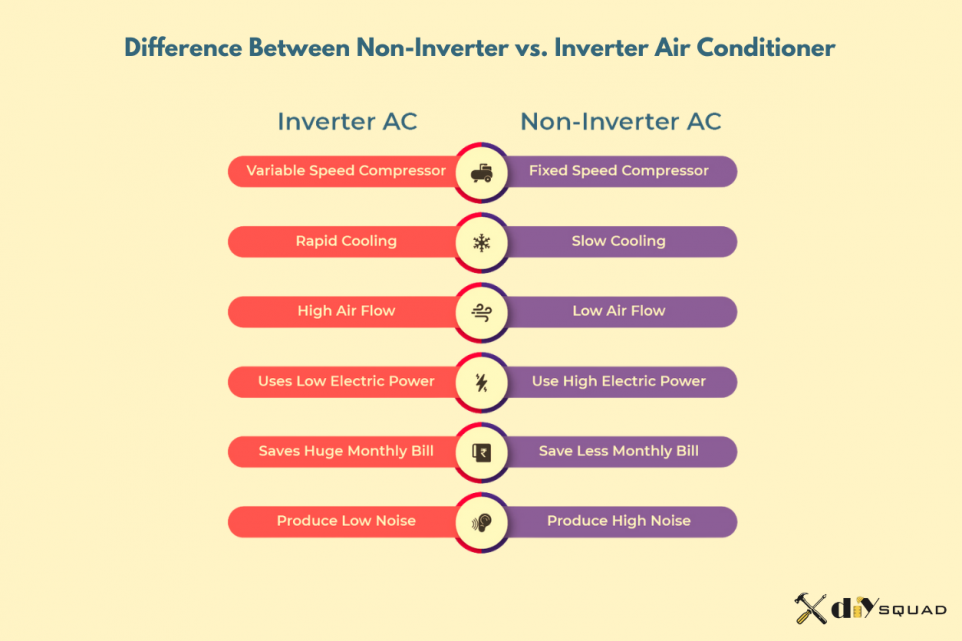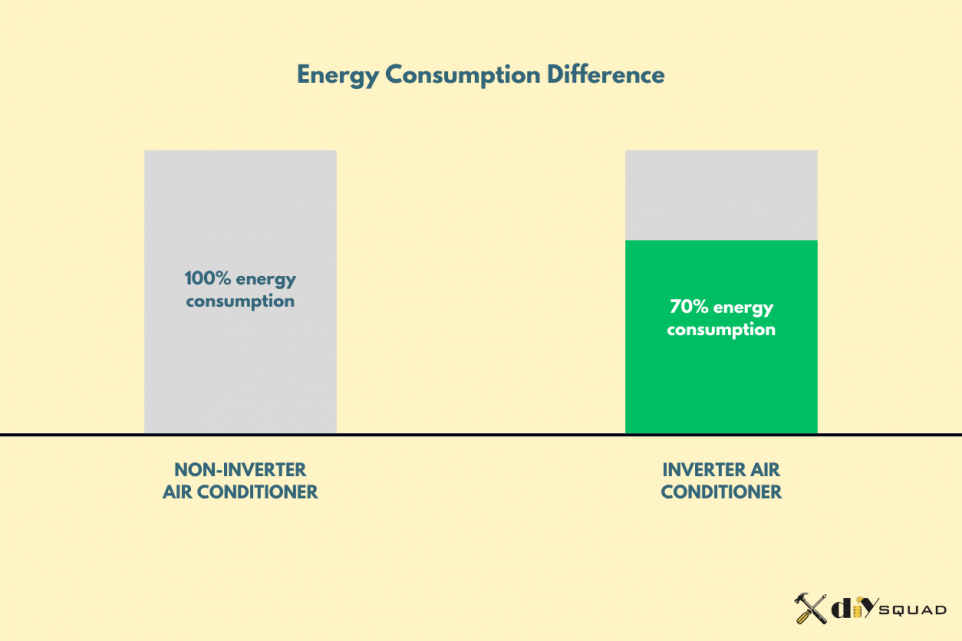Non-Inverter vs. Inverter Air Conditioner: What is the Difference?

The thought of coming home to a cool, comfortable haven after a sweltering day is a non-negotiable comfort. However, choosing the right air conditioner isn’t just about escaping the heat; it’s also about how efficiently you can keep the chill without watching your electricity bills skyrocket. This guide dives deep into the world of air conditioners, focusing on the key differences between inverter and non-inverter models, and provides insights into how you can optimize your unit for peak performance while keeping those energy costs in check. Whether you’re looking for a new AC or to maximize the efficiency of your current setup, this article is your go-to resource for staying cool and cost-effective.
What Is an Inverter AC?
Inverter air conditioners represent a revolution in the way we cool our homes, stepping away from the traditional approach of all-or-nothing operation. Unlike conventional non-inverter units that operate at full throttle or not at all, inverter ACs adjust their compressor speed to match the precise cooling demand. This technology allows the system to maintain a consistent room temperature by modulating the compressor’s speed without frequent on-off cycles, leading to increased efficiency, reduced wear and tear on the system, and significant energy savings.
The core of an inverter system lies in its ability to operate continuously but at varying speeds. Traditional AC systems are often likened to using a car pedal: you can either press it all the way down to full speed or lift it off to stop. In contrast, an inverter AC functions more like a car with a continuously variable transmission, where the speed is finely adjusted to maintain consistent travel speed despite varying road conditions. This analogy underscores how inverter ACs maintain comfort levels with precise temperature control and reduced energy consumption.
How Does an Inverter AC Work?
Understanding the workings of an AC inverter begins with understanding its compressor. The compressor is the heart of the air conditioning system, and in an inverter unit, it can adjust its speed based on the cooling needs of the room. This adaptability is achieved through advanced electronics that regulate the electrical current to the compressor, allowing it to operate at variable speeds.
Typically, when an inverter AC starts up, it runs at full capacity to reach the desired temperature swiftly. Once this temperature is achieved, instead of shutting off completely, the compressor slows down to maintain the temperature rather than cycling off and on repeatedly. This modulation is where the efficiency and energy savings primarily come from. The ability to run at lower speeds for extended periods reduces drastic temperature fluctuations and, consequently, the energy used to continually stop and start the compressor.
This type of system is smart enough to assess external and internal conditions. Advanced inverter ACs are equipped with sensors that measure indoor temperatures and even gauge the outdoor climate to optimize their operation. For instance, on a mildly warm day, the system may run at a significantly reduced capacity, thereby conserving energy while still keeping the room comfortably cool.

What Are Non-Inverter ACs?
Non-inverter ACs, also known as traditional or conventional air conditioners, operate with fixed-speed compressors. These units are designed to cool a space to a set temperature and then switch off the compressor until the room temperature rises above a certain threshold. Once the room warms up to this threshold, the compressor restarts to cool the room again. This on/off cycle is characteristic of non-inverter ACs and distinguishes them from their inverter counterparts.
The primary mechanism of action in non-inverter ACs is quite straightforward. The compressor operates at full power or not at all. This type of operation can lead to noticeable fluctuations in room temperature because the unit is either running at maximum capacity or completely off, which might not always align perfectly with the cooling needs of the space.
How Do Non-Inverter ACs Work?
The operation cycle of a non-inverter AC begins when the indoor temperature sensor detects that the room temperature is higher than the AC’s set temperature. At this point, the compressor kicks in at full capacity and begins to circulate refrigerant to cool the room. As the air conditioner lowers the room’s temperature, it continues to run at full throttle until the set temperature is reached.
Once the target temperature is achieved, the compressor shuts off, but the fan may continue to circulate air. During this off phase, the room temperature will naturally begin to rise due to external heat or internal heat sources. When the temperature exceeds the set point, typically by a degree or two, the compressor restarts, and the cycle repeats.
This method of cooling can lead to a higher variation in temperature compared to inverter systems, as the air conditioner does not adjust the cooling output gradually but rather switches on and off to maintain the desired temperature. This can sometimes create a ‘stop-start’ feel to the environment, which might not be as comfortable as the more consistent output provided by an inverter AC.
Energy Consumption Comparison: Non-Inverter vs. Inverter Air Conditioner
When it comes to energy efficiency, inverter ACs have a clear advantage over non-inverter ACs due to their advanced technology and operation dynamics. Non-inverter air conditioners operate with a simple on/off system where the compressor turns on at full capacity to cool the room and then turns off once the desired temperature is achieved. This process can lead to significant energy usage because the unit consumes full power each time it turns on.
In contrast, inverter ACs are equipped with variable-speed compressors that adjust their cooling output based on the room’s temperature demand. This means that once an inverter AC achieves the set room temperature, it reduces its compressor speed to maintain the temperature rather than turning off completely. This modulation avoids the energy-intensive start-up process repeatedly and maintains a more constant room temperature with less power consumption.
To put these concepts into practical terms, consider a scenario where an inverter AC initially powers up to full capacity to cool a room quickly. For example, if a room is set to be cooled to 26 degrees Celsius, an inverter AC might pull around 1.8 kilowatts initially. However, once the room reaches the desired temperature, the inverter technology allows the unit to reduce its power consumption significantly. It might drop down to consuming only about 600 watts to maintain the set temperature, showcasing an impressive reduction in energy use.

In comparison, a non-inverter AC would cool the room to 24 degrees Celsius and then shut off. When the temperature rises back to 26 degrees Celsius or above, it restarts and consumes the same high energy level as initially—typically around 1.1 kilowatts in this example. This stop-start cycle is less energy-efficient and can lead to higher electricity bills over time.
The efficiency of inverter ACs can translate to up to 30% or more in energy savings compared to non-inverter models. This efficiency becomes especially significant during peak summer months when air conditioners run for extended periods. The ability of inverter ACs to operate at varying capacities means they consume only as much power as needed to maintain comfort rather than cycling on and off at full load. This not only saves energy but also reduces wear and tear on the AC unit, potentially extending its lifespan.